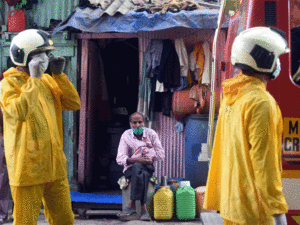Social Distancing in Mumbai's Slums
"Police flew a drone over our neighbourhood and saw some people sitting outside collecting water.
So they came and started hitting people with their sticks."
"I was standing in the doorway and they pushed me inside."
Unidentified resident, Dharavi, Mumbai
"I don't feel right about it, we're not animals."
"But this kind of thing is not new for us [experimental inoculations on groups of people living in Mumbai slums]."
"Shopkeepers are raising prices day by day [with staples like matchboxes, rice and nuts now more expensive]."
Sabina Khan, Dharavi resident
"Residents [of the Dharavi slum] feel they will be treated badly, as usual."
"And that comes from their long experience with public hospitals and authorities."
Vinod Shetty, founder, Acorn Foundation, NGO, India
![Concerns after Mumbai's Dharavi slum reports COVID-19 cases An estimated 700,000 to 1 million people are crammed in the Dharavi slum [Prashant Waydande/Reuters]](https://www.aljazeera.com/mritems/imagecache/mbdxxlarge/mritems/Images/2020/4/3/e68ececbec384214b8c379b697ebd73e_18.jpg) |
| An estimated 700,000 to 1 million people are crammed in the Dharavi slum [Prashant Waydande/Reuters] |
 |
| So far, eight patients fromDharavi have died |
Javed Shaik, a tour guide, explained that in Dharavi food has become even scarcer during this time of lockdown in India and halted production. Police, he said, attack people with sticks any time they venture outside of their cramped homes. His own is an example, where he lives with five other members of his family in cramped quarters. "It's very, very tiny. It's liked a small cage", he said.
India's coronavirus epidemic has persuaded the government of Narendra Modi to institute lockdown orders. Shops have been closed, and when food becomes short, residents attempt to venture out of their homes to find food where they can. Food markets are open for several morning hours daily, and then there is the black market.
 |
| Photo India Today |
Authorities have increased measures for the lockdown to be enforced. Hospitals across the country are overwhelmed with a reported 23,452 cases of COVID-19, among them 723 deaths. Dharavi's million population lives in poorly ventilated, dense housing, leading to expectations that residents will be badly affected by the highly contagious virus.
The local economy has reached standstill proportions as increased numbers of people become affected by the virus. Mumbai officials are giving consideration to inoculating people in Dharavi along with another slum nearby, with the antimalarial drug hydroxychloroquine, hoping it might be effective in providing a measure of immunity against the virus, despite that it has never been proven to be useful for that purpose.
When news of that prospect reached residents, some have complained they are being treated like laboratory animals, to trial a potential vaccine with no proven effectiveness for the purpose envisioned. This is a drug known to have serious side-effects, such as increased risk of heart attacks, nausea and blurred vision.
As for social distancing mandated by the central government, it is quite impossible in the packed, crowded living conditions of a slum, leaving containment in a position akin to impossible. Community lavatories service hundreds of people. Throngs of residents stand in line to purchase food at markets open only for several hours in the morning.
 |
| Coronavirus: Mumbai has the highest number of COVID-19 cases in India |
Labels: India, Infections, Mumbai, Novel Coronavirus, Slums, Social Distancing

0 Comments:
Post a Comment
<< Home